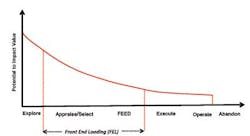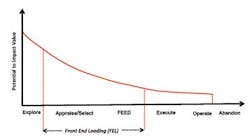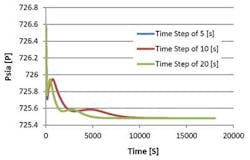Fluid sampling, subsea processing help maximize deepwater development
Abili N.
Citi G.
Gassert M.
Eni E&P
Energy demands for oil and gas have driven offshore operators to explore for viable solutions to maximize the recoverable volume of deep offshore assets with innovative technologies. Forecasts from a subsea processing game changer report shows that expenditure on subsea processing systems is expected to exceed $3.4 billion, with deepwater expenditures expected to increase by 130% to $260 billion by 2018. A contributing factor driving this is the demand to deploy over 1,000 additional subsea multi-phase flowmeters, (SMPFM) which provides well diagnostics to measure individual phases (oil, gas, water) without the need for complex conventional testing operations.
Responding to the increase in subsea tree orders for greenfield developments, manufacturers are now developing more SMPFM products to meet well diagnostic demands. In addition, the industry is optimistic on marginal field development prospects (on average 200 to 300 MMbbl each) and growth in viable brownfields. More than 70% of the world's oil and gas production comes from older brownfields, marking a trend for application of enhanced oil recovery (EOR) technologies to meet global demands, such as subsea processing. Due to current development trends, there is pressure on operators to manage capex and opex, increase efficiencies, guarantee flow assurance, and increase production.
The deepwater market requires higher capex which is expected to rise from 38% in 2012 to 53% by 2017. This implies that deepwater operators must increase production by maximizing their operating wells in order to future-proof return on investment (ROI). Therefore, SMPFM plays an important role in the financial ROI over the life of the field, and must be configured to determine the optimal recoverable reserves of each production well.
Growth trends in deep and ultra-deepwater development demonstrate a need to increase hydrocarbon output while improving the asset's net present value. The new application of subsea fluid sampling systems, subsea separators, compressors, multi-phase pumps, and the qualification of critical components would enable remote long-distance assets (even with low reservoir pressure) to be developed economically. Offering improved flow assurance and energy efficient processes to topside facilities, these subsea processing technologies are being proven and qualified for deepwater operations, with extensive qualifications under way for ultra-deepwater developments.
Furthermore, the synergy of subsea fluid sampling and subsea processing has evolved into a solution for transforming potential oil and gas reserves into economic ROI. Thus, by adding accurate fluid samples, the potential value of subsea processing can be realized on increased production volume.
Field life cycle
The life cycle design for subsea engineering development requires six distinct project phases: explore, appraise/select, FEED, execute, operate, and abandon. The ability to influence the value of the design as it progresses from the appraisal/selection phase to abandonment, follows a logarithmic curve.
The curve shows that the front-end-loading (FEL) region of the engineering design (appraisal/select through FEED) determines the value of the design factor (time, availability and life circle cost). The FEL influences the value for subsea system development, as 80% of the project life cycle is realized at this phase of early engineering development, which accounts for about 20% of the entire project schedule. Therefore, time and effort must be invested during early engineering to get the right design at the conceptual phase.
Development scenarios
Several large oil and gas fields are being developed with multi-phase meters and wet-gas meters. These instruments provide essential data for optimizing production, measuring oil, gas, water fractions, and flowrates.
Recent research and development championed by major operators and original equipment manufacturers is focusing on improving the performance of the metering systems; such as the use of an SMPFM with the developed subsea fluid sampling system implemented at mid-life of the field to check and calibrate the data.
This has created opportunities to improve understanding of the well flow stream for reservoir monitoring, using available transient multi-phase flow model and redundant metering sensors. Obtaining accurate fluid samples for PVT and compositional analysis is vital to understanding the reservoir characteristics, enabling the design optimization and the advancement of subsea facilities.
ROV sampling systems
Oceaneering International, Inc., and others have developed ROV capabilities for deployment on deepwater development, providing a reasonable alternative for fluid sampling from subsea facilities. The ability to acquire subsea fluid samples from well production systems without the need for a static platform is key.
The new generation of subsea fluid sampling technologies uses an ROV, a sample collection device, known as a sampling skid, and a storage facility for the collected fluid. The collecting device recovers samples of the fluid from the subsea tree, which is then taken to the vehicle's storage facility. Samples are carried to a second location with temperature and pressure intact, ensuring safe delivery for laboratory analysis.
Subsea fluid sampling provides insight into process conditions at the time of a sample collection. The objective is to collect a representative sample which can be defined as having its physical or chemical characteristics identical to the fluid properties being sampled. This enables the adjustment of SMPFM calibration, bringing many benefits to operators.
Accurate data and detailed knowledge of the reservoir enables efficient production on brownfield and greenfield developments. For fields that have been in production for more than 10 years with life extension capacity, the need for accurate data is vital. This fact, connected to the uncertainty of accuracy in the data currently available or simply the lack of detailed knowledge, reflects the need to acquire reliable data to support EOR programs.
Subsea sampling module
The subsea sampling module (SSM) is ROV operated, providing connections to the subsea sampling interface (SSI). It operates the SSI pressure barriers and captures the required fluid samples by pumping the fluids from the production flow loop or sample point into the sample bottles. It is designed to capture representative samples of the three phases (oil, water, and gas) in isobaric and isothermal conditions. It can meet different requirements in quantity in one subsea deployment, and for use in a wider range of applications.
The SSM is compatible with ROV interface for flexibility of differing sampling applications such as flow rates, water cuts, gas volume fraction (GVF), and viscosities.
Subsea sampling interface
The subsea sampling interface (SSI) is installed in the subsea tree or manifold to capture sample fluids upstream of the SMPFM. It can be installed as a hardware structure or be included in a retrievable flow control module (FCM) – SMPFM and choke module – on the SPS. In this case, the sampling interfaces, barriers, etc., are packaged in a dedicated fluid sampling FCM with provision for interchangeability to standard production FCM. It is designed to capture a representative sample of each phase (oil, water, and gas) in a wide range of flow conditions, taking into consideration flowrates, phase distribution, and physical properties.
The SSI includes sampling lines that tap into the production flow path, and the remotely activated valves, 2 or 4 on each sampling line, depending on requirements, all of which are fail-safe in the close position. The ROV provides the connections between the SSI and the sampling skid. The SSI can be configured for vertical access sampling, as is normally required for manifolds, or for horizontal access as the preferred option for integration into an SPS tree.
Sampling operation is done in a steady condition to secure representative samples over a certain time period in the flow-loop. This ensures sample accuracy in case of unstable flow and provides the volume needed to perform laboratory analysis topside. The SSM can house 9 to 12 sample bottles, based on project specific requirements. To maximize value on the sampling operations is to incorporate the subsea fluid sampling program into the periodic subsea intervention operations to reduce the high cost of vessel entry and ROV deployments.
While there are benefits, there are still limitations to their deployment, recovery methods, payload ratings, dexterity, and available power sources. Equipment for retrieval and deployment can be mounted on the ROV, allowing for greater payload and complexity, especially in the case of the subsea sampling operations. This could restrict access due to the physical size of the combined ROV and sampling skid during operations. However, research on ROV manipulation and deployment is ongoing for subsea intervention operations. By exploring cost effective solutions, such as the virtual fluid sampling model, the subsea industry can manage the challenges faced by reservoir production uncertainty.
Integrated virtual model
The development of an integrated fluid sampling model was based on virtual compositional fluid tracking results. This captures the essential elements of the simulation model to compare both the input and output of simulated results to check and verify the performance of the SMPFM.
This development is a cost-effective subsea reservoir fluid sampling approach to reduce the frequency of operations in retrieving a subsea sample with the potential to reduce the costs of intervention and risk of exposure to the subsea environment. To achieve operational success with the integrated virtual fluid sampling model, an optimized novel sampling strategy was developed for deepwater field development.
This sampling strategy is required on each individual production well, depending on the pressure profile of the well during early-, mid-, and late-life of subsea field operations. The integration and benefits of applying this strategy add value to the virtual compositional fluid tacking model application. The virtual fluid sampling model would be a useful predictive tool for operators and regulatory authorities to manage the challenges on subsea fluid sampling operations for accurate understanding of the reservoirs and impact on production facilities.
A deepwater field off West Africa validated the results in a case study. It showed a simulated pressure profile with compositional fluid tracking, which was compared with the experimental base pressure data from a test loop facility.
The validation provides accurate PVT and compositions of reservoir fluid properties of the subsea tree. A transient multi-phase flow simulation environment was selected to develop the virtual fluid sampling model, capturing the essential building blocks of the SPS and simulations to test the model.
Pressure results of the test show that the convergence of pressure drops from 726.6psi (50 bar) down to 725 psi (49.9 bar) over 20,000 seconds. Comparing the simulated numerical results with experimental results, the pressure at 730 psi (50.3 bar) shows that at 300 m (984 ft) of pipeline length, the simulated results have a 3% drop in pressure from the experimental result. This is from the relatively low pressure due to slip mode effect, liquid hold up, slugging, or turbulence, in the multi-phase flow caused by pressure fluctuations. Also, as the pressure drops to 715 psi (49.2 bar) along the pipeline length of 2,650 m (8,694 ft), the simulated pressure was in phase with the experimental pressure. This is due to steady conditions of the multi-phase flow. So at a 50% drop of total pressure, the pressure is representative of the experimental results.
A convergence test analysis shows a pressure drop of 700 psi (48.2 bar) at the 4,700 m (15,420 ft) along the pipeline. The simulated pressure exhibited the same result with less than 2% slip mode effect of the fluid compositions on multiphase flow. This demonstrates that both results are represented with the pressure trend. Therefore, acquired results of the validation of the virtual fluid sampling model provide a predictive tool to track fluid compositions in multi-phase flow. This enables representative fluid sampling that can inform operational conditions of subsea production facilities, for proactive monitoring and cost efficient operations.
The integrated virtual fluid sampling model benefits oil and gas production. It provides the capability to improve the understanding of well stream flow and retrieve information from parts of the production system that instrumentation can not reach. It enables a proactive and cost-effective sampling operation on a subsea production facility, allowing the development of advanced operational monitoring through the life-of-field.
Thus, the capability of the integrated virtual fluid sampling model has been demonstrated to track fluid compositional changes, an innovative breakthrough, where field measurement instruments can not reach. It also provides an enhanced strategy to manage field production operations. The model presents a predictive tool to match the performance of SMPFM for accurate monitoring of the well stream fluid. Therefore, with the integrated virtual fluid sampling model, a separate check on SMPFM is achievable.
Synergy in deepwater development
The combination of operational and system strategies provides the right optimization to maximize asset value in deepwater developments. Employing the synergies of subsea fluid sampling (physical and virtual sampling), subsea processing (conditioning, separation, boosting, compression and re-injection), treatment of fluid through injection of chemicals on subsea facilities, operational control philosophy, and the planning of step outs/architectures enables a holistic development of deepwater assets.
Subsea fluid sampling adds value in field developments, which is demonstrated in a typical application to test the characteristics of different fluid components on a merging network. This is applicable for well streams commingling into a manifold, and for tracking individual components of the well to provide an accurate measurement and allocation of production revenue, as well as when to employ subsea processing during the life-of-field development.
After a subsea separation process, water can be re-injected into the reservoir with reduced energy consumption required to deliver the separated hydrocarbon fluid produced to the topside facilities. The synergy of fluid sampling and subsea processing provides an optimized approach to maximize growth in hydrocarbon volume production.
While project planning, one needs to understand when to introduce subsea processing; not all fields require major processing at the early phase of production. If an initial field study indicates that water breakthrough is not expected until after the third year of production, it may not be necessary to install water separation equipment from the start. Also, if the natural flow pressure is sufficient, then boosting equipment may not be necessary until the third year of production. Therefore, a proper field assessment study is required before making any final investment decisions about using subsea processing to maximize asset recovery.
By acquiring subsea fluid samples, accurate fluid properties are obtained, which are essential for effective reservoir evaluation and management. Retrieving accurate fluid samples are linked to the value creation and realization in employing subsea processing on field development. The synergy between the developed virtual fluid sampling model and ROV deployed fluid sampling have been identified as the optimal solution to acquire representative fluid samples, to validate and calibrate SMPFM.
Acknowledgment
Based on a paper presented at the Deep Offshore Technology International Conference & Exhibition held in Aberdeen, Scotland, October 14-16, 2014.


